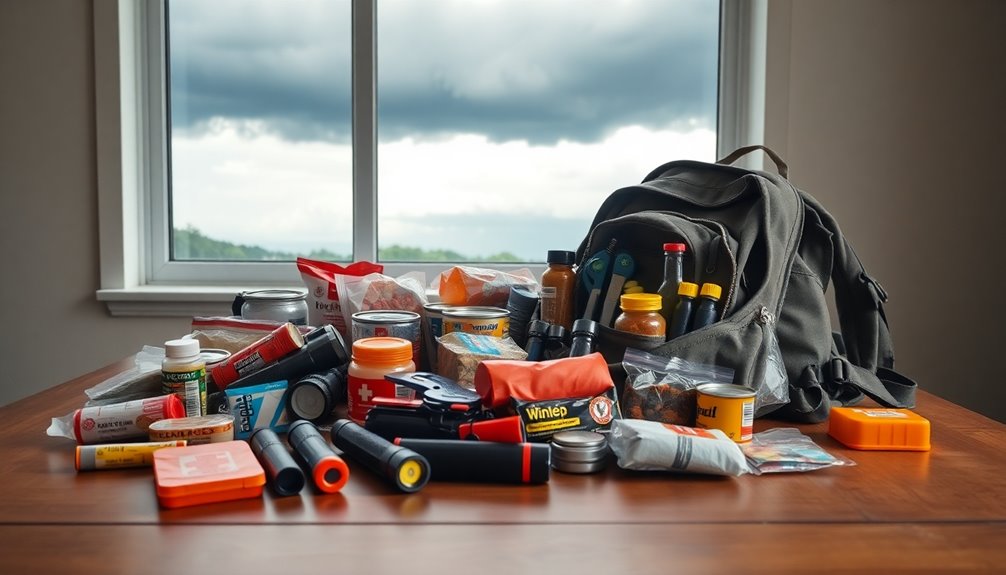To evacuate safely during emergencies, guarantee your assistive devices are in good condition with spare parts and batteries ready. Develop a clear plan that considers your mobility needs, including a designated meeting spot outside your home. Practice evacuation drills regularly and coordinate with family, neighbors, and emergency services. Keep important medical records and supplies accessible in an emergency kit. Staying prepared and knowing your options can make all the difference—expand your plan to stay safer when seconds count.
Key Takeaways
- Prepare and regularly update an emergency kit with medications, assistive devices, batteries, and important documents for quick evacuation.
- Develop a personalized evacuation plan considering mobility limitations, including safe routes and designated meeting spots.
- Familiarize yourself with the operation of assistive devices and keep spare parts, batteries, and chargers accessible.
- Conduct practice drills with family or caregivers to identify and address potential evacuation obstacles.
- Maintain contact with emergency services and community support resources for assistance during emergencies.

Evacuating during an emergency can be especially challenging for seniors and disabled individuals, but proper planning can make the process safer and less stressful. One of the most effective ways to prepare is by understanding how assistive devices can support your evacuation efforts. These devices, such as wheelchairs, walkers, hearing aids, and mobility scooters, are essential tools that help maintain independence and safety during emergencies. Ensuring that your assistive devices are in good condition and easily accessible is a critical part of your emergency planning. Keep spare batteries, chargers, and backup devices on hand, and familiarize yourself with how to quickly operate or secure them during a crisis. Additionally, understanding essential resources available for emergency support can significantly enhance your safety and preparedness.
Developing a thorough emergency plan tailored to your needs is essential. Start by identifying the types of emergencies most likely to occur in your area—whether natural disasters like hurricanes or earthquakes, or other crises such as fires or power outages. Your plan should include clear instructions for how to quickly and safely leave your home, taking into account your mobility limitations and the use of assistive devices. Establish a designated safe meeting spot outside your home where you and your loved ones can regroup after evacuating. Share your plan with family members, neighbors, or caregivers who can assist if needed, and make sure everyone knows your specific needs and the best ways to support you.
Create a personalized emergency plan with clear evacuation steps and a designated safe meeting spot.
Packing an emergency kit is another key component. Include essentials like medications, copies of prescriptions, medical records, and contact information for your healthcare providers. Make sure your assistive devices, along with any replacement parts or batteries, are packed and ready to go at a moment’s notice. Keep important documents and a list of emergency contacts in an accessible, waterproof container.
Practicing your evacuation plan regularly helps you identify potential obstacles and guarantees everyone involved understands their role. Conduct drills with family, friends, or caregivers, and always review your plan after each practice to make improvements. Additionally, coordinate with local emergency services or community organizations that offer assistance to seniors and disabled residents. They can provide valuable resources, such as transportation or specialized support, which can be lifesaving during a real emergency.
Frequently Asked Questions
How Can I Create an Emergency Evacuation Plan With My Caregivers?
To create an emergency evacuation plan with your caregivers, start by discussing your specific needs and personal safety concerns. Coordinate with family members to assign roles and guarantee everyone knows the plan. Practice evacuation routes regularly, keep essential supplies accessible, and update the plan as needed. Clear communication and teamwork help keep you safe, ensuring that everyone is prepared and confident in managing emergencies together.
What Mobility Aids Are Best During Emergency Evacuations?
For emergency evacuations, choose a mobility device that guarantees wheelchair accessibility and suits your needs. A sturdy, lightweight wheelchair or motorized scooter often works best for quick movement and ease of transport. Consider your environment—stairlifts or stair chairs are helpful if you encounter stairs. Always have a portable, easy-to-use mobility device on hand, and practice using it regularly to ensure safety and confidence during emergencies.
How Do I Communicate My Needs During an Evacuation?
Think of your needs as a lighthouse guiding responders through fog. To communicate effectively during an evacuation, overcome communication barriers by carrying a written card detailing your needs and emergency signaling preferences. Use simple gestures or signals you’ve practiced, ensuring responders understand your situation quickly. Keep your communication tools accessible, and inform loved ones and emergency personnel about your needs beforehand, so your voice shines through any confusion or noise.
Are There Community Resources for Evacuation Assistance?
Yes, community resources can help during evacuations. You can access community transportation services tailored for seniors and disabled individuals, making it easier to leave safely. Many organizations also offer financial assistance programs to cover evacuation-related costs. Reach out to local agencies, senior centers, or disability advocacy groups to learn about available support. These resources are designed to guarantee you get the help you need quickly and safely during emergencies.
How Can I Practice Evacuation Drills Safely at Home?
Practicing evacuation drills at home is like rehearsing a play—you want to be prepared. Start by reviewing your home safety plan and identifying clear escape routes. Practice these routes regularly, simulating different scenarios, but do so safely. Keep pathways clear and avoid rushing. You can also use timers to track your response time. Regular practice guarantees your evacuation preparation becomes second nature, making real emergencies less stressful.
Conclusion
Remember, preparation is your trusted companion during uncertain times. By understanding your needs, creating a personalized plan, and staying informed, you’ll navigate challenges with confidence and grace. Think of it as a gentle dance—each step carefully planned, leading you safely to calmer waters. Embrace this journey with optimism, knowing that a little foresight today can turn any storm into a smooth passage tomorrow. Your safety and peace of mind are worth every thoughtful step.










